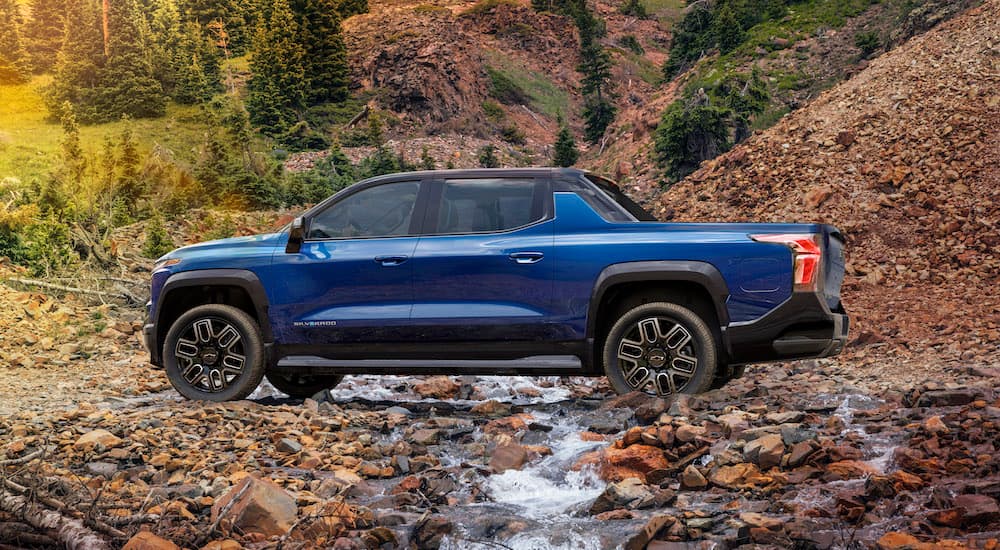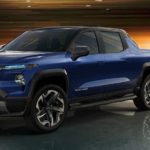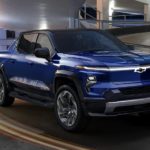Chevy didn’t rush into the fledgling electric vehicle (EV) pickup segment but rather bided its time and let some of its closest competitors take the lead. This might sound like an overly cautious approach and was probably hard for longtime Silverado fans who were waiting to experience the new all-electric version of the popular pickup, but Chevy’s patience certainly looks to have paid off. The Silverado EV was able to avoid many of the growing pains that have plagued other EV pickups while cherry-picking some of the segment’s best features and letting less successful experiments fall by the wayside.
The result is one of the most versatile all-electric trucks on the market, and things only seem to be getting better as Chevy unveils the 2025 model. Offering the best range in its class, not to mention four-wheel steering, a foldable midgate, and the ability to act as a backup generator for your entire house, the Silverado EV offers a well-rounded package that showcases some of the highlights of the EV pickup segment. Read on as we explore five features that make a compelling case for test-driving a Silverado EV for sale at your local Chevy dealership and learn how the pickup compares to some other all-electric newcomers.
Four-Wheel Steering and the Sidewinder Feature
The ability to send power to all four wheels allows all-electric pickups like the Silverado EV to perform a few unique party tricks that are useful in both on- and off-road scenarios. Electronic four-wheel steering not only dramatically enhances traction to provide a safe, consistent ride, but it can also go a long way toward maximizing maneuverability by allowing the front and rear wheels to turn in opposite directions. The feature can be used when the Silverado EV is moving at slower speeds, letting the truck perform tight turns that traditional gas-powered pickups would struggle to match.
Four-wheel steering might be an innovative feature, but it’s just one example of the convenience and utility that the Silverado EV offers. When the pickup enters Sidewinder Mode, the front and rear wheels can move in tandem, giving drivers the ability to essentially drive diagonally at low speeds. The Silverado EV’s Sidewinder diagonal driving feature enables the truck to maneuver in tight spaces, avoid off-road obstacles, and nestle into even the smallest parking spot with ease. The technology first debuted on the Silverado’s GM cousin in the GMC Hummer EV, where it’s branded as CrabWalk, and has since expanded to a growing number of EV pickups like the Rivian R1T and Mercedes-Benz all-electric G-Wagon.
Sidewinder Mode, which can be activated through the truck’s dashboard touchscreen infotainment system, goes a long way towards improving the Silverado EV’s maneuverability and handling. While the feature is currently limited to the 2025 Silverado EV’s RST trim, early adopters will also be able to access the technology thanks to an over-the-air update for 2024 First Edition RST models. It might sound like a novelty, but it’s just one example of how a new generation of all-electric vehicles is allowing automotive engineers to build a better pickup.
Best-in-Class Range
So-called “range anxiety” is still commonly cited as one of the major hurdles in the widespread adoption of electric vehicles, especially in areas that are lagging behind in terms of charging infrastructure. In order for EVs to compete with their gas-powered pickups, they need to be just as convenient as their predecessors, which means fast charging times and high-capacity batteries. Chevy has certainly taken this to heart when designing the Silverado EV, which tops the segment with nearly 500 miles of range.
This lofty figure is made possible thanks to GM’s Ultium battery technology, which is quickly proving itself to be some of the industry’s best. While the largest battery packs on Tesla, Ford, and Rivian’s EV pickups are limited to 122-, 133- and 144-kWh, respectively, the Silverado EV’s Ultium battery can be scaled up to as large as 205 kWh. When paired with the Silverado’s Work Truck trim, this Max Range battery offers an EPA-estimated 492 miles of range that gives the Chevy a noticeable advantage over the competition.
Rivian’s R1T comes the closest with 420 miles of range, but Tesla and Ford aren’t even in the same ballpark, with just 325 and 320 miles to their name. Swapping the Max range battery out for the Extended range version will limit drivers to 422 miles in the Work Truck, 408 in the LT and 390 in the RST, but no matter which version you choose, you’ll get access to a quick-charging capability that allows the EV to add up to 100 miles of range in just 10 minutes when utilizing a DC charging station.
High-Voltage Power
If you have any doubts about the performance potential of an electrically-powered pickup, the Silverado EV is here to quell any doubts. Chevy has designed the 2025 model with a dual-motor design that churns out up to 760 hp, 785 lb-ft of torque, and can speed from zero to 60 mph in 4.5 seconds when activating the truck’s Wide Open Watts mode. In order to achieve that sort of power you’ll have to opt for the range-topping RST model, though even the mid-range LT is built around a 645-hp setup. Prior to the advent of modern all-electric pickups, a near-700-horsepower engine would mark the Silverado as a leader in its class, but the bar has certainly been raised in a hurry. The base WT trim offers 510 hp and, like every Silverado EV, comes standard with all-wheel drive.
The Silverado EV’s powertrain posts some impressive horsepower and torque, but these numbers can almost start to become a little abstract past a certain point. The truck’s towing capacity provides a more useful example of its ability at 12,500 lbs, not to mention 1,800 lbs of payload capacity. So, how do those numbers stack up in the emerging EV pickup segment? Comparing the Silverado EV with similar offerings from Ford, Rivian, and Tesla helps to shine a little light on the situation.
Rivian’s R1T might have the first all-electric pickup on the North American market, but this doesn’t earn it any points in the towing department with a maximum rating of 11,000 lbs for the 2025 model. Tesla’s Cybertruck matches that figure while Ford’s F-150 Lighting trails behind the pack at just 10,000 lbs. These results come as little surprise when you consider the gulf in performance between the four models. The F-150 Lightning tops out at just 580 hp, while the Cybertruck fares a bit better at 834 horses. There’s just one catch: in order to achieve that sort of power, Tesla drivers will have to opt for the Tri-Motor Beast trim, which starts at an eye-watering $102,000-plus.
MultiFlex Midgate/Tailgate
While the Silverado EV’s range, power, and towing ability tend to garner all the headlines, Chevy hasn’t lost sight of one of the hallmarks of any good pickup: cargo capacity. The truck’s 10.7-cubic-foot frunk and 5-foot, 11-inch bed provide plenty of storage capacity for tools, building supplies, or equipment for your next weekend adventure, but it’s the Silverado’s EV’s ability to make the most of this space that really sets the Chevy apart in the competitive segment.
The EV’s most innovative feature would have to be its Multi-Flex Midgate. By allowing drivers to fold away the back wall of the cab, the Silverado’s 5-foot-11-inch bed can extend to more than nine feet. Those looking to accommodate larger cargo can even remove the glass panel that normally occupies the top half of the midgate, creating a wide-open storage area that maximizes the truck’s utility while giving the Silverado a unique, airy feel. The Silverado EV isn’t the first truck to offer such a feature, but the technology has certainly come a long way over the last few years. While the earliest fold-away gates were a little bulky, most drivers should be able to manipulate the Multi-Flex midgate without any outside assistance.
A nine-foot cargo bed would easily put the Silverado EV towards the top of its class in terms of storage capacity, but Chevy isn’t stopping there. The all-electric pickup also features Chevy’s Multi-Flex Tailgate, a versatile design that can seamlessly shift between six different functions. When deployed in its primary gate load stop mode, the Multi-Flex Tailgate extends the bed’s length to almost 11 feet. The built-in loadstop will keep everything safe and secure, while the bed’s considerable cargo capacity means you can accommodate all the lumber, plywood, or piping you need for your next project without making multiple trips to the building supply store.
The Multi-Flex Tailgate also includes a full-width step, inner gate laid stop, integrated work surface, and built-in dampers that can gently lower the hatch to avoid the wear and tear that can come with constant slamming. These features prove that, EV powertrain aside, Chevy hasn’t lost sight of those features that have long made the Silverado such a popular choice amongst those who value utility.
Tech (and Power) on Tap
When the power goes out, homeowners are usually left with two options: firing up a gas-powered generator or roughing it 19th-century style with some candles and flashlights. The Silverado EV provides a thoroughly modern alternative to these two choices, with its lithium-ion battery pack allowing the truck to double as a backup generator that can power an entire home.
The Silverado’s vehicle-to-home (V2H) power technology flips the script on the typical charging routine; instead of using your home’s power to top off your EV’s battery, the Silverado can tap its battery to provide an entire household with up to 21 days of power with 10.2kW of power at your disposal. This bi-directional charging technology is an intriguing feature, but it will require a bit of an investment on the part of the driver. GM Energy’s V2H bundle will currently run you around $7,300, and it is only available in a handful of states. That might sound like a good chunk of change, but it’s still a value when compared to competing systems like Tesla’s Powerwall at $11,500. In addition to seeing you through an unexpected power outage, the V2H system can also be used to reduce a home’s energy costs by storing power when electricity rates are low and kicking in when the price starts to rise.
The Silverado EV’s electric powertrain and V2H capability are just the tip of the iceberg when it comes to the pickup’s arsenal of cutting-edge tech. The truck also features all the screen time you could ask for, with a digital rearview mirror, a 17.7-inch infotainment touchscreen, an 11-inch Digital Information Cluster, and a 14-inch heads-up display. Throw in up to 10 AC outlets and GM’s advanced Super Cruise hands-free autonomous driving technology, and it’s easy to see why the Silverado EV has become such a force to be reckoned with in the EV pickup segment.
The Silverado EV Continues Its Electrifying Evolution
The Silverado EV enjoyed a strong debut, turning plenty of heads and earning a nomination as “North American Truck of the Year,” but Chevy has already made some important upgrades for 2025 by introducing a new Standard Range battery and adding a new mid-tier LT trim that bridges the gap between the value-packed Work Truck and luxury-focused RST. It’s a strong sophomore showing for the Silverado EV and has us excited to see what Chevy might be cooking up for 2026. Chevy’s electric pickup bests its rivals by almost any metric you could imagine, offering best-in-class range, plenty of power, and unique features like the Sidewinder Mode, the Multi-Flex tailgate, and the Midgate. Given the Silverado’s perennial success in the full-size pickup segment, the EV’s resume comes as little surprise. While all-electric pickups might still carry a higher price than their gas-powered counterparts, they made a pretty convincing argument from a performance perspective.






